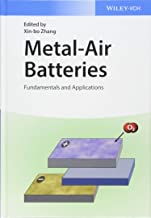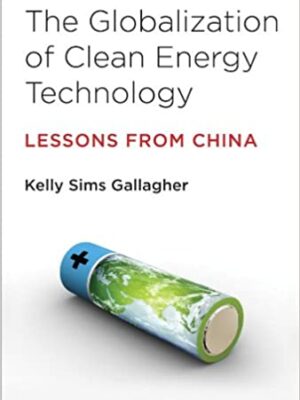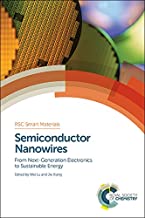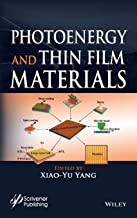Metal-Air Batteries: Fundamentals and Applications
Original price was: ₹15,826.00.₹12,660.80Current price is: ₹12,660.80.
ISBN: 9783527342792
Author/Editor: Xin-be Zhang
Publisher: John Wiley
Year: 2018
2 in stock (can be backordered)
Description
A comprehensive overview of the research developments in the burgeoning field of metal-air batteries An innovation in battery science and technology is necessary to build better power sources for our modern lifestyle needs. One of the main fields being explored for the possible breakthrough is the development of metal-air batteries. Metal-Air Batteries: Fundamentals and Applications offers a systematic summary of the fundamentals of the technology and explores the most recent advances in the applications of metal-air batteries. Comprehensive in scope, the text explains the basics in electrochemical batteries and introduces various species of metal-air batteries. The author-a noted expert in the field-explores the development of metal-air batteries in the order of Li-air battery, sodium-air battery, zinc-air battery and Mg-O2 battery, with the focus on the Li-air battery. The text also addresses topics such as metallic anode, discharge products, parasitic reactions, electrocatalysts, mediator, and X-ray diffraction study in Li-air battery. Metal-Air Batteries provides a summary of future perspectives in the field of the metal-air batteries. This important resource: -Covers various species of metal-air batteries and their components as well as system designation -Contains groundbreaking content that reviews recent advances in the field of metal-air batteries -Focuses on the battery systems which have the greatest potential for renewable energy storage Written for electrochemists, physical chemists, materials scientists, professionals in the electrotechnical industry, engineers in power technology, Metal-Air Batteries offers a review of the fundamentals and the most recent developments in the area of metal-air batteries.
Additional information
| Weight | 0.982 kg |
|---|
Product Properties
| Year of Publication | 2018 |
|---|---|
| Table of Contents | 1 Introduction 1 1.1 Introduction 1 1.2 Fluid Machinery: Classification and Characteristics 2 1.3 Analysis of Fluid Machinery 4 1.4 Design of Fluid Machinery 7 1.4.1 Design Requirements 7 1.4.2 Determination of Meanline Parameters 7 1.4.3 Meanline Analysis 8 1.4.4 3D Blade Design 8 1.4.5 Quasi 3D Through-Flow Analysis 8 1.4.6 Full 3D Flow Analysis 8 1.4.7 Design Optimization 8 1.5 Design Optimization of Turbomachinery 9 References 10 2 Fluid Mechanics and Computational Fluid Dynamics 11 2.1 Basic Fluid Mechanics 11 2.1.1 Introduction 11 2.1.2 Classification of Fluid Flow 11 2.1.2.1 Based on Viscosity 12 2.1.2.2 Based on Compressibility 12 2.1.2.3 Based on Flow Speed (Mach Number) 12 2.1.2.4 Based on Flow Regime 13 2.1.2.5 Based on Number of Phases 14 2.1.3 One-, Two-, and Three-Dimensional Flows 14 2.1.3.1 One-Dimensional Flow 15 2.1.3.2 Two- and Three-Dimensional Flow 15 2.1.4 External Fluid Flow 15 2.1.5 The Boundary Layer 15 2.1.5.1 Transition from Laminar to Turbulent Flow 16 2.2 Computational Fluid Dynamics (CFD) 16 2.2.1 CFD and its Application in Turbomachinery 17 2.2.1.1 Advantages of Using CFD 18 2.2.1.2 Limitations of CFD in Turbomachinery 18 2.2.2 Basic Steps Involved in CFD Analysis 19 2.2.2.1 Problem Statement 19 2.2.2.2 Mathematical Model 19 2.2.3 Governing Equations 19 2.2.3.1 Mass Conservation 20 2.2.3.2 Momentum Conservation 20 2.2.3.3 Energy Conservation 21 2.2.4 Turbulence Modeling 21 2.2.4.1 What is Turbulence? 22 2.2.4.2 Need for Turbulence Modeling 22 2.2.4.3 Reynolds-Averaged Navier?tokes Equations 22 2.2.4.4 Turbulence Closure Models 23 2.2.4.5 Large Eddy Simulation (LES) 27 2.2.4.6 Direct Numerical Simulation (DNS) 27 2.2.5 Boundary Conditions 27 2.2.5.1 Inlet/Outlet Boundary Conditions 28 2.2.5.2 Wall Boundary Conditions 28 2.2.5.3 Periodic/Cyclic Boundary Conditions 28 2.2.5.4 Symmetry Boundary Conditions 29 2.2.6 Moving Reference Frame (MRF) 29 2.2.7 Verification and Validation 30 2.2.8 Commercial CFD Software 30 2.2.9 Open Source Codes 31 2.2.9.1 OpenFOAM 31 References 32 3 Optimization Methodology 35 3.1 Introduction 35 3.1.1 Engineering Optimization Definition 36 3.1.2 Design Space 36 3.1.3 Design Variables and Objectives 37 3.1.4 Optimization Procedure 40 3.1.5 Search Algorithm 40 3.2 Multi-Objective Optimization (MOO) 41 3.2.1 Weighted Sum Approach 42 3.2.2 Pareto-Optimal Front 42 3.3 Constrained, Unconstrained, and Discrete Optimization 43 3.3.1 Constrained Optimization 43 3.3.2 Unconstrained Optimization 44 3.3.3 Discrete Optimization 44 3.4 Surrogate Modeling 44 3.4.1 Overview 44 3.4.2 Optimization Procedure 44 3.4.3 Surrogate Modeling Approach 44 3.4.3.1 Response Surface Approximation (RSA) Model 45 3.4.3.2 Artificial Neural Network (ANN) Model 46 3.4.3.3 Kriging Model (KRG) Model 47 3.4.3.4 PRESS-Based-Averaging (PBA) Model 47 3.4.3.5 Simple Average (SA) Model 48 3.5 Error Estimation 49 3.5.1 General Errors When Simulating and Optimizing a Turbomachinery System 49 3.5.2 Error Estimation in Surrogate Modeling 52 3.5.3 Sensitivity Analysis 55 3.5.3.1 Number of Variables and Performance Improvement 55 3.5.3.2 Example of Sensitivity Analysis 56 3.6 Sampling Technique 57 3.6.1 Sampling 57 3.6.2 Sample Size 57 3.6.3 Design Space 57 3.6.4 Dimensionality Curse 57 3.6.5 Design of Experiments (DOE) 57 3.6.6 Full Factorial Design 58 3.6.7 Latin Hypercube Sampling (LHS) 58 3.7 Optimizers 59 3.8 Multidisciplinary Design Optimization 59 3.8.1 What is Multidisciplinary Optimization? 59 3.8.2 Gradient-Based Methods 60 3.8.3 Non-Gradient-Based Methods 60 3.8.4 Recent MDO Methods 60 3.9 Inverse Design 60 3.9.1 Inverse Design versus Direct Design 60 3.9.2 Direct Design Optimization with CFD 61 3.9.3 Inverse Design Optimization with CFD 61 3.10 Automated Optimization 61 3.10.1 Coupling Method with Adjoint CFD 63 3.10.2 Case Studies 63 3.10.2.1 CFD-Based Design Automated Design Optimization for Hydro Turbines 63 3.10.2.2 AO with OPAL++ 65 3.10.2.3 PADRAM: Parametric Design and Rapid Meshing System for Turbomachinery Optimization 65 3.10.2.4 Problems of AO 66 3.11 Conclusions 68 References 68 4 Optimization of Industrial Fluid Machinery 71 4.1 Pumps 71 4.1.1 Centrifugal, Mixed-Flow, and Axial-Flow Pumps 71 4.1.1.1 Centrifugal (or Radial) Pumps 71 4.1.1.2 Mixed-Flow and Axial-Flow Pumps 72 4.1.2 Parametric Shape Models and Flow Solvers for Pump Optimization 73 4.1.2.1 1D Models 73 4.1.2.2 2D Models 82 4.1.2.3 3D Models 88 4.2 Compressors and Turbines 98 4.2.1 Axial, Radial, Multistage Compressors 98 4.2.2 Parametric Shape Models and Flow Solvers for Axial Compressor Optimization 99 4.2.2.1 1D Models 99 4.2.2.2 2D Models 100 4.2.2.3 Advanced Throughflow Design Techniques (2D) 101 4.2.2.4 Streamline Curvature Methods 102 4.2.2.5 Advanced Cascade Design Techniques (2D-Quasi-3D) 105 4.2.2.6 Geometry Definition and Parameterization 107 4.2.2.7 Flow Solvers 111 4.2.2.8 3D Methods 114 4.2.3 Radial Compressor Optimization 117 4.2.3.1 3D Models 118 4.2.3.2 CFD Analysis 121 4.2.3.3 Multi-Objective Optimization Problem and Results 122 4.2.4 Turbines 124 4.2.4.1 Axial-Flow Turbines 126 4.2.4.2 Outflow and Inflow Turbines 126 4.2.4.3 Axial 1D 127 4.2.4.4 Case Study: Multi-Point Optimization of an Axial Turbine Stage 131 4.2.4.5 Axial 2D 135 4.2.4.6 CFD Models: Implementation and Validation 135 4.2.4.7 Case Study: Description, Geometry Parametrization, and Meshing 138 4.2.4.8 Results 140 4.2.4.9 RSM 142 4.2.4.10 SQP 142 4.3 Fans 146 4.3.1 Centrifugal, Axial-Flow, Mixed-Flow, and Cross-Flow Fans 146 4.3.1.1 Axial-Flow Fans 146 4.3.1.2 Centrifugal Fans 147 4.3.1.3 Mixed-Flow Fans 148 4.3.1.4 Cross-Flow Fans 149 4.3.2 Fan Pressure, Efficiency, and Laws 149 4.3.3 Aerodynamic Analysis of Fans 151 4.3.3.1 Axial-Flow Fans 151 4.3.3.2 Centrifugal Fans 160 4.3.4 Optimization Problems and Algorithms Used for Fan Optimization 171 4.3.4.1 Axial-Flow Fans 171 4.3.4.2 Axial-Flow Fans 175 4.3.4.3 Centrifugal Fans 184 4.4 Hydraulic Turbines 192 4.4.1 Introduction 192 4.4.2 Cavitation in Hydraulic Turbines 195 4.4.3 Analysis of Hydraulic Turbines 200 4.4.3.1 Francis Turbines 200 4.4.3.2 Kaplan Turbines 207 4.4.3.3 Pump-Turbines 210 4.4.4 Optimization of Hydraulic Turbines 213 4.4.4.1 Kaplan Turbines 213 4.4.4.2 Francis Turbines 216 4.4.4.3 Draft Tubes and Others 223 4.4.4.4 Pump-Turbines 224 4.5 Others 226 4.5.1 Regenerative Blowers 226 4.5.2 Others 232 References 240 5 Optimization of Fluid Machinery for Renewable Energy Systems 257 5.1 Wind Energy 257 5.1.1 Optimization of Horizontal-Axis Wind Turbines 259 5.1.2 Blade Element Methods 260 5.1.3 Turbine Parameterization 261 5.1.4 Strategies for Rotor Optimization 264 5.2 Ocean Energy 264 5.2.1 Temperature Gradients 266 5.2.2 Tides and Tidal Currents 266 5.2.3 Salinity Gradients 266 5.2.4 Waves 266 5.3 Energy Extraction from Ocean Waves 266 5.4 Oscillating Water Column (OWC) 267 5.4.1 Fixed-Structure OWC 269 5.4.2 Floating-Structure OWC 269 5.5 Classification of Turbines 269 5.5.1 Wells Turbine 269 5.5.2 Impulse Turbine 272 5.6 Optimization of Air Turbines 272 References 276 Nomenclature 279 Index 287 |
| Author | Xin-be Zhang |
| ISBN/ISSN | 9783527342792 |
| Binding | Hardback |
| Edition | 1 |
| Publisher | John Wiley |
You must be logged in to post a review.






Reviews
There are no reviews yet.